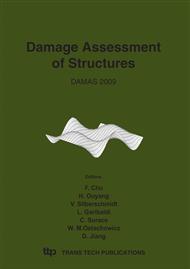[1]
BS 7910: Guide to methods for assessing the acceptability of flaws in metallic structures, British Standards Institution, London (2005).
Google Scholar
[2]
BS 7608: Code of practice for Fatigue design and assessment of steel structures, British Standards Institution, London (1993).
Google Scholar
[3]
DNV-RP-C203: Fatigue design of offshore steel structures, Det Norske Veritas (2005).
Google Scholar
[4]
Buitrago J and Weir M S: Experimental fatigue evaluation of deepwater risers in mild sour service, Deep Offshore Technology Conference, New Orleans, USA (2002).
Google Scholar
[5]
McMaster F, Thompson H, Zhang M, Walters D and Bowman J: Sour service corrosion fatigue testing of flowline welds, OMAE2007-29060, Proceedings of OMAE2007 26th International Conference on Offshore Mechanics and Arctic Engineering, San Diego, California, USA (2007).
DOI: 10.1115/omae2007-29060
Google Scholar
[6]
Buitrago J, Baxter D and Hudak S: High-cycle and low-cycle fatigue resistance of girth welds in sour service, OMAE2008-57545, Proceedings of 27th International Conference on Offshore Mechanics and Arctic Engineering, Estoril, Portugal (2008).
DOI: 10.1115/omae2008-57545
Google Scholar
[7]
McMaster F, Bowman J, Thompson H, Zhang M and Kinyon S: Sour service corrosion fatigue testing of flowline and riser welds, OMAE 2008-57059, Proceedings of 27th International Conference on Offshore Mechanics and Arctic Engineering, Estoril, Portugal (2008).
DOI: 10.1115/omae2008-57059
Google Scholar
[8]
Smith A and Osman M: Comparison of safety factors used for the determination of remaining life of girth welded pipelines using fracture mechanics and conventional endurance assessment techniques, OMAE2008-58050, Proceedings of the 27th International Conference on Offshore Mechanics and Arctic Engineering, Estoril, Portugal (2008).
DOI: 10.1115/omae2008-58050
Google Scholar
[9]
Baxter D P, Maddox S J, Pargeter R J: Corrosion fatigue behaviour of welded risers and pipelines, OMAE2007-29360, Proceedings of OMAE2007 26th International Conference on Offshore Mechanics and Arctic Engineering, San Diego, California, USA (2007).
DOI: 10.1115/omae2007-29360
Google Scholar
[10]
Petruska D, Ku A, Masson C, Cook H, McDonald W and Spong R: Calculation of reliabilitybased safety factors for establishing defect acceptance criteria for deepwater riser welds, Deep Offshore Technology Conference (D.O.T. ) (2006).
Google Scholar
[11]
Bristoll P and Roeleveld J: Fatigue of offshore structures: effect of seawater on crack propagation in structural steel, Proc. Conf. European Offshore Steels Research, ECSC (1978).
Google Scholar
[12]
Webster S E, Austen I M and Rudd W J: Fatigue, corrosion fatigue and stress corrosion of steels for offshore structures, ECSC Report No. EUR 9460, ECSC Steel Publications, European Commission, Brussels (1985).
Google Scholar
[13]
Pargeter R J, Gooch TG and Bailey N: The effect of environment on threshold hardness for hydrogen induced stress corrosion cracking of C-Mn steel welds', Conference Proceedings 'Advanced Technology in Welding, Materials, Processing and Evaluation, Japan Welding Soc, Tokyo, April (1990).
Google Scholar
[14]
Sponseller D L: Corrosion, Vol. 48 (1992) p.159.
Google Scholar


